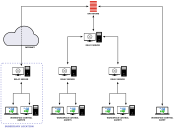Relay Server
The Relay Server enables to create a flexible architecture by consolidating and centralizing all Ivanti Workspace Control configuration data in one central database, while ensuring that Workspace Control Agents spread across multiple sites receive configuration data efficiently and promptly.
Relay Servers are an optional part of the infrastructure. They cache data from the Workspace Control Datastore and distribute it to the Workspace Control Agents or other Relay Servers. Workspace Control Agents can be set up to connect directly to the Workspace Control Datastore or to use Relay Servers instead. When Relay Servers are used, Workspace Control Agents no longer need to connect directly to the Workspace Control Datastore.
In Workspace Control, both methods can operate simultaneously—some Workspace Control Agents may connect directly to the Workspace Control Datastore, while others use Relay Servers.
The Relay Servers offer several advantages:
-
Enhance scalability across various distributed network setups.
-
Reduce network traffic in multi-site environments by limiting direct connections to the central Workspace Control Datastore over slow links.
-
Decrease the load on the central Workspace Control Datastore by reducing direct connections.
-
Allow Workspace Control Agents to operate without requiring a database driver for the Workspace Control Datastore.
Cascaded Relay Servers
In an environment with cascaded Relay Servers where more than 50,000 transactions exist in the queue of one of the Relay Servers or there is less than 500 MB free disk space on the Relay Server, the Relay Server will stop to accept new transactions from Workspace Control Agents or other Relay Servers. They are then redirected to another Relay Server. When the queue has been reduced to 40,000 queued transactions or free disk space increased by 10% to 550 MB, the Relay Server will accept new transactions again.
For further details about Relay Servers, see the document Getting Started with Workspace Control Relay Servers.
